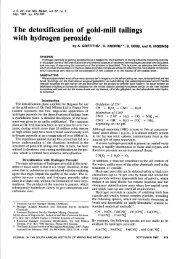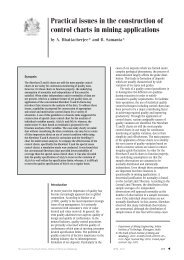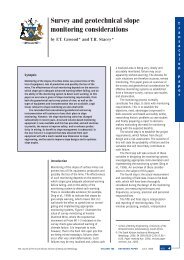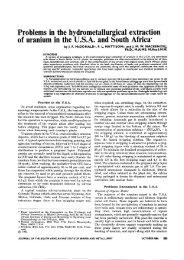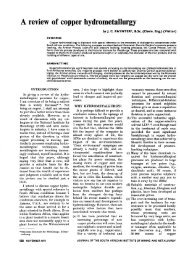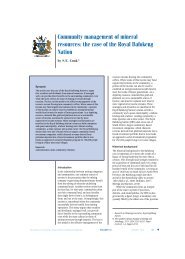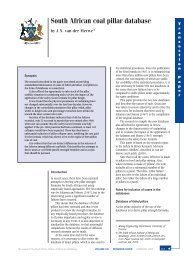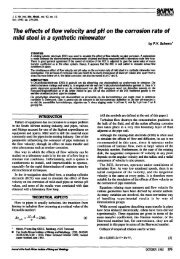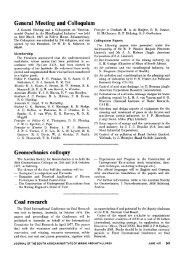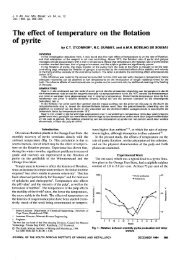The intensive cyanidation of gold-plant gravity concentrates - saimm
The intensive cyanidation of gold-plant gravity concentrates - saimm
The intensive cyanidation of gold-plant gravity concentrates - saimm
You also want an ePaper? Increase the reach of your titles
YUMPU automatically turns print PDFs into web optimized ePapers that Google loves.
I,ll to 1,19 gfcm3 for potassium aurocyanide solutions in<br />
the temperature range 15 to 35 °C.<br />
It is clear from the results presented that high-grade<br />
<strong>gold</strong> <strong>concentrates</strong> pose certain practical limitations on<br />
the choice <strong>of</strong> leaching conditions when sodium cyanide<br />
is used as a leaching agent. Both higher reaction temperatures<br />
(30 to 40 °C) and higher liquid: solid ratios ( > 2: I)<br />
are indicated if precipitation <strong>of</strong> the <strong>gold</strong> is to be avoided.<br />
While the use <strong>of</strong> potassium cyanide as an alternative<br />
leaching agent may well allow a far greater latitude in<br />
the choice <strong>of</strong> such reaction parameters, the additional<br />
cost and availability <strong>of</strong> potassium cyanide may militate<br />
against its use. <strong>The</strong> present programme was confined to<br />
the solubility <strong>of</strong> potassium and sodium aurocyanides,<br />
illustrating the important role played by solubility in the<br />
<strong>intensive</strong> <strong>cyanidation</strong> <strong>of</strong> <strong>gold</strong> <strong>concentrates</strong>. Such findings<br />
immediately suggest that the presence <strong>of</strong> calcium or<br />
magnesium may likewise play a very important role in<br />
the <strong>cyanidation</strong> <strong>of</strong> <strong>gold</strong> <strong>concentrates</strong>, and further<br />
investigation in this direction appears to be necessary<br />
(see later).<br />
<strong>The</strong> Effect <strong>of</strong> Oxygenation and Agitation<br />
<strong>The</strong> earlier investigations had indicated that pulp<br />
aeration and agitation may play a very vital role in<br />
effecting efficient <strong>gold</strong> and silver dissolution from such<br />
high-grade material. It was thus necessary to investigate<br />
such variables using several means <strong>of</strong> mechanical<br />
agitation. <strong>The</strong> use <strong>of</strong> paddle agitation, a Super-agitator<br />
(Denver Equipment nomenclature), and a flotation<br />
machine was considered in the present investigation,<br />
which was confined to the treatment <strong>of</strong> sample W3<br />
(<strong>gold</strong> 12,2 kg/t and silver 1200 g/t) at a liquid: solid ratio<br />
<strong>of</strong> 2:1 unless otherwise specified.<br />
For paddle agitation, a series <strong>of</strong> experiments was<br />
designed so that variable flow-rates <strong>of</strong> oxygen and air,<br />
together with the efficiency <strong>of</strong> agitation at various<br />
reaction times, could be investigated. Cyanidation was<br />
carried out in a loosely covered 2-litre glass beaker<br />
maintained at 25 °C in a water-bath in which the pulp<br />
was agitated by means <strong>of</strong> a paddle. Oxygen or air was<br />
added in controlled quantities through a sintered-glass<br />
gas distributor located near the bottom <strong>of</strong> the vessel.<br />
Two different impeller speeds and two different paddle<br />
sizes were investigated.<br />
From Table V it can be seen that the kinetics <strong>of</strong> <strong>gold</strong><br />
and silver dissolution are again faster with oxygen than<br />
with air, but that, at longer reaction times, the residual<br />
values obtained with air are similar to those' obtained<br />
with oxygen (compare Test No. 7 with Test No. 15).<br />
Furthermore, the lower stirring speed (400 r/min) gave<br />
consistently poor <strong>gold</strong> extractions as compared with the<br />
higher speed (800 r/min) , <strong>The</strong> effect <strong>of</strong> paddle size,<br />
although significant, is less obvious. On the other hand,<br />
the amount <strong>of</strong> oxygen added, either in the form <strong>of</strong> air<br />
or as pure oxygen, had no significant effect on <strong>gold</strong><br />
extractions down to a critical level, which in the prescribed<br />
experimental conditions was approximately<br />
10 cm3/min (see Test Nos. 11 and 12). Iron dissolution<br />
can be seen to be higher when the final cyanide concentration<br />
was low (Table V, Test Nos. 14, 14B, 16, 16B, 17,<br />
19,21, and 23), the lower sodium cyanide limit appearing<br />
to be around 3 g/l. This appeared to indicate that cementation<br />
may occur at low concentrations <strong>of</strong> residual<br />
cyanide. Table V also shows that the cyanide consumption<br />
is not significantly affected by either air or oxygen.<br />
Longer reaction times increase the cyanide consumption<br />
marginally.<br />
As the above results again emphasize the importance<br />
<strong>of</strong> efficient agitation and aeration, a similar exercise was<br />
carried out with a small Super-agitator type <strong>of</strong> system.<br />
<strong>The</strong> Super-agitator vessel was loosely covered, and air<br />
or oxygen was added at a controlled rate by means <strong>of</strong> a<br />
sintered-glass distributor located near the bottom <strong>of</strong> the<br />
vessel. <strong>The</strong> impeller speed was controlled at 1800 r/min,<br />
and the temperature was maintained at 25°C in all<br />
cases.<br />
As Table VI shows, the kinetics <strong>of</strong> <strong>gold</strong> and silver<br />
dissolution are faster with oxygen than with air, but,<br />
given sufficient time, air produced residual values similar<br />
to that <strong>of</strong> oxygen. An increase in the leaching time from<br />
6 to 16 hours lowered the residual values marginally<br />
when oxygen was used but dramatically when air was<br />
used. An increase in the leaching time from 16 to 24<br />
hours using air decreased the residual values only<br />
marginally. Residual values tended towards a minimum,<br />
possibly determined by the amount <strong>of</strong> occluded <strong>gold</strong><br />
present in the concentrate sample. With regard to the<br />
dissolution <strong>of</strong> iron and copper, it can be seen that the<br />
iron dissolution increases with time and is lower with<br />
oxygen than with air for shorter reaction times (6<br />
hours). As before, when the final cyanide concentration<br />
was reduced, the iron dissolution was found to be higher,<br />
which again indicated that cementation occurs at lower<br />
cyanide concentrations, confirming previous observations.<br />
<strong>The</strong> copper dissolution, on the other hand, appeared<br />
to be quite unaffected by such changes in reaction<br />
variables.<br />
As the above results again emphasized the importance<br />
<strong>of</strong> efficient agitation and oxygenation, a third<br />
mechanism, viz a conventional flotation machine, was<br />
also investigated. <strong>The</strong> leaching vessel was completely<br />
sealed, apart from a small vent hole. Air or oxygen was<br />
fed conventionally at a controlled rate through the<br />
agitator shaft <strong>of</strong> the flotation machine. <strong>The</strong> impeller<br />
speed was 1800 r/min and the reaction time 6 hours in<br />
all cases. <strong>The</strong> temperature was controlled by a water<br />
jacket. As shown in Table VII, the kinetics <strong>of</strong> <strong>gold</strong> and<br />
silver dissolution are faster with oxygen than with air,<br />
the effects being more marked with sodium cyanide than<br />
with potassium cyanide. An increase in the temperature<br />
from 25 to 35 °C using oxygen also reduced the residual<br />
<strong>gold</strong> value from 32,6 to 18,6 g/t, and an increase in the<br />
cyanide addition from 30 to 70 kg/t reduced the residual<br />
<strong>gold</strong> value from 32,6 to 20,6 g/t - an effect that is<br />
probably purely kinetic. Potassium cyanide at a liquid:<br />
solid ratio <strong>of</strong> I :2 gave lower residual values than sodium<br />
cyanide at a liquid: solid ratio <strong>of</strong> 2:1 for a given temperature<br />
and cyanide addition, both with air and with<br />
oxygen. <strong>The</strong> iron dissolution was again lower with<br />
oxygen than with air (possibly a cementation effect), and<br />
higher with potassium cyanide than with sodium cyanide<br />
(possibly owing to higher pH). An increase in the<br />
temperature from 25 to 35 °C had no effect, but an<br />
JOURNAL OF THE SOUTH AFRICAN INSTITUTE OF MINING AND METALLURGY JANUARY 1978 155




